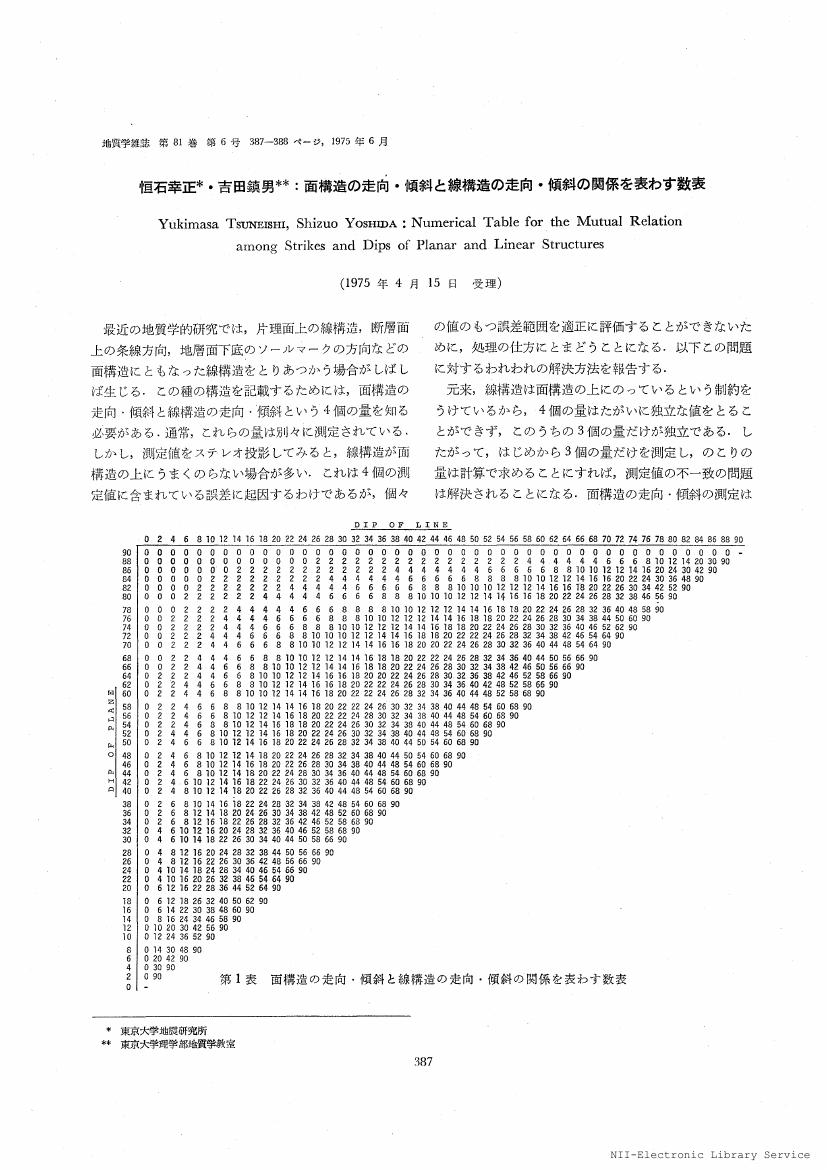1 0 0 0 OA 面構造の走向・傾斜と線構造の走向・傾斜の関係を表わす数表
- 著者
- 恒石 幸正 吉田 鎮男
- 出版者
- 一般社団法人 日本地質学会
- 雑誌
- 地質学雑誌 (ISSN:00167630)
- 巻号頁・発行日
- vol.81, no.6, pp.387-388, 1975-06-15 (Released:2008-04-11)
1 0 0 0 面構造の走向・傾斜と線構造の走向・傾斜の関係を表わす数表
- 著者
- 恒石 幸正 吉田 鎮男
- 出版者
- 日本地質学会
- 雑誌
- 地質学雑誌 (ISSN:00167630)
- 巻号頁・発行日
- vol.81, no.6, pp.387-388, 1975
1 0 0 0 OA 松代群発地震地域とその周辺地方の地質
- 著者
- 森本 良平 村井 勇 松田 時彦 中村 一明 恒石 幸正 吉田 鎮男
- 出版者
- 東京大学地震研究所
- 雑誌
- 東京大學地震研究所彙報 = Bulletin of the Earthquake Research Institute, University of Tokyo (ISSN:00408972)
- 巻号頁・発行日
- vol.44, no.1, pp.423-445, 1966-07-25
Geology of the main seismic area in and around the town of Matsushiro, the northern part of Nagano Prefecture, central Japan, is investigated by field and literature surveys for the better understanding of the earthquake-swarm which is now taking place. The Matsushiro earthquake-swarm started at the beginning of August, 1965. Since then, the local seismicity has become more active with occasional rise and fall.
1 0 0 0 OA 73.岐阜県中部地震-1969年9月9日-被害地調査報告
- 著者
- 松田 時彦 恒石 幸正
- 出版者
- 東京大学地震研究所
- 雑誌
- 東京大學地震研究所彙報 = Bulletin of the Earthquake Research Institute, University of Tokyo (ISSN:00408972)
- 巻号頁・発行日
- vol.48, no.6, pp.1267-1279, 1971-02-27
A locally destructive earthquake with magnitude 6.6 occurred in Okumino area, Gifu Prefecture, Central Japan on September 9, 1969 (Fig. 1). The damage area is underlain mainly by Paleozoic formations and Cretaceous rhyolitic pyroclastic deposits, which are partly covered with dissected Quaternary volcanoes (Figs. 2 and 3). A number of Quaternary faults which are dominantly of strike-slip nature, occur in Central Japan which includes the epicentral area (Fig. 6). The epicentral area is located about 10km west of a main fault of the Atera fault system, which is an active left-lateral strikeslip fault of Central Japan. Although a few active faults are in the meisoseismal area, no definite evidence of surface faulting was found along any active fault, except some echelon cracks suggesting a left-slip on a fault line at one locality. The push pull distribution of P waves (Fig. 1), the distribution of aftershocks and the shape of the meisoseismal area (Fig. 5) suggest the concealed seismic fault to be a northwest-trending left-lateral strike-slip fault, which strikes parallel to the Atera fault and has the same sense of displacement. The direction of maximum pressure of the present earthquake corresponds well with the Quaternary stress direction, which has been inferred from the study of active fault systems in Central Japan.
1 0 0 0 OA 松代群発地震地域とその周辺地方の地質
- 著者
- 森本 良平 村井 勇 松田 時彦 中村 一明 恒石 幸正 吉田 鎮男
- 出版者
- 東京大学地震研究所
- 雑誌
- 東京大学地震研究所彙報 (ISSN:00408972)
- 巻号頁・発行日
- vol.44, no.1, pp.423-445, 1966-07-25
Geology of the main seismic area in and around the town of Matsushiro, the northern part of Nagano Prefecture, central Japan, is investigated by field and literature surveys for the better understanding of the earthquake-swarm which is now taking place. The Matsushiro earthquake-swarm started at the beginning of August, 1965. Since then, the local seismicity has become more active with occasional rise and fall.
1 0 0 0 EDM観測による花蓮市(台湾)付近の地震予知
- 著者
- 許 華杞 恒石 幸正
- 出版者
- The Geodetic Society of Japan
- 雑誌
- 測地学会誌 (ISSN:00380830)
- 巻号頁・発行日
- vol.42, no.2, pp.111-113, 1996
1 0 0 0 OA 73.岐阜県中部地震-1969年9月9日-被害地調査報告
- 著者
- 松田 時彦 恒石 幸正
- 出版者
- 東京大学地震研究所
- 雑誌
- 東京大学地震研究所彙報 (ISSN:00408972)
- 巻号頁・発行日
- vol.48, no.6, pp.1267-1279, 1971-02-27
A locally destructive earthquake with magnitude 6.6 occurred in Okumino area, Gifu Prefecture, Central Japan on September 9, 1969 (Fig. 1). The damage area is underlain mainly by Paleozoic formations and Cretaceous rhyolitic pyroclastic deposits, which are partly covered with dissected Quaternary volcanoes (Figs. 2 and 3). A number of Quaternary faults which are dominantly of strike-slip nature, occur in Central Japan which includes the epicentral area (Fig. 6). The epicentral area is located about 10km west of a main fault of the Atera fault system, which is an active left-lateral strikeslip fault of Central Japan. Although a few active faults are in the meisoseismal area, no definite evidence of surface faulting was found along any active fault, except some echelon cracks suggesting a left-slip on a fault line at one locality. The push pull distribution of P waves (Fig. 1), the distribution of aftershocks and the shape of the meisoseismal area (Fig. 5) suggest the concealed seismic fault to be a northwest-trending left-lateral strike-slip fault, which strikes parallel to the Atera fault and has the same sense of displacement. The direction of maximum pressure of the present earthquake corresponds well with the Quaternary stress direction, which has been inferred from the study of active fault systems in Central Japan.
